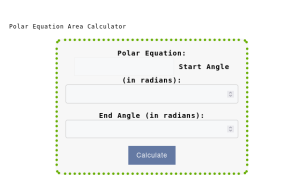Polar Equation Area Calculator
Polar Equation Area Calculator
Polar Equation Area Calculator
The Polar Equation Area Calculator is a tool used to calculate the area enclosed by a polar equation within a specified angle range. This calculator is particularly useful in mathematics, physics, and engineering fields where polar coordinates and polar equations are utilized.
Try out our Fringe Rate Calculator.
Formula and Example
Calculating the area enclosed by a polar equation involves integrating the equation over the specified angle range. The formula for calculating the area is as follows:
Area = ∫[startAngle, endAngle] 0.5 * r(θ)^2 dθ
where:
- startAngle: The starting angle of integration (in radians)
- endAngle: The ending angle of integration (in radians)
- r(θ): The polar equation that defines the radius as a function of the angle θ
- ∫[startAngle, endAngle] denotes the definite integral over the specified angle range
Here’s an example to illustrate the calculation:
Consider the polar equation r(θ) = 2 + 4cos(θ). We want to find the area enclosed by this equation within the angle range of π/6 to π/2.
To calculate the area, we integrate the equation over the specified angle range:
Area = ∫[π/6, π/2] 0.5 * (2 + 4cos(θ))^2 dθ
To obtain the exact result, a more advanced integration algorithm or software tool may be required.
Frequently Asked Questions (FAQs)
- Q: Can I use the calculator for polar equations in degrees instead of radians? A: The Polar Equation Area Calculator uses radians as the unit of measurement for angles. If you have angles in degrees, you will need to convert them to radians before entering them into the calculator. The conversion can be done using the formula: radians = (π/180) * degrees.
- Q: What if the polar equation has multiple curves or disjoint regions? A: The calculator assumes a single closed curve or region defined by the polar equation. If the equation represents multiple curves or disjoint regions, you will need to evaluate and integrate each region separately to calculate the total enclosed area.
- Q: What if the polar equation is not given in terms of r(θ)? A: The calculator expects the polar equation to be in terms of the radius r as a function of the angle θ. If the equation is given in a different form (e.g., in Cartesian coordinates), you will need to convert it to the polar form before using the calculator. There are mathematical techniques and formulas available for converting equations between different coordinate systems.

Try More Calculators:
